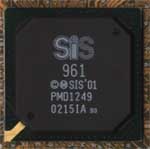Construction - Under the Hood Continued
The top side of the i-Buddie XP's motherboard is almost indistinguishable from the top side of the i-Buddie 4's motherboard. Both feature the same chips and the same configuration.
The i-Buddie XP makes use of the SiS 961 southbridge which is mounted on the top side of the motherboard. The chip provides an AC '97 audio controller, a USB 1.1 controller, an ethernet controller, and two IDE channels compliant with the ATA100 specification.
USB 2.0 support and IEEE-1394 support are brought to the i-Buddie XP thanks to VIA. The USB 2.0 controller is a VIA VT6202 chip mounted on the left side of the motherboard. On the opposite corner a VIA VT6306 controller is found. This chip serves as the firewire controller for the i-Buddie 4.
Providing s-video out functionality to the i-Buddie XP is a SiS 301LVMV chip. The chip works in conjunction with the integrated video in the SiS 740 northbridge to perform video encoding functions and apparently gets warm enough during operation to justify the small black heatsink mounted on top of it.
Also found on the bottom side of the i-Buddie 4's motherboard are three Winbond chips, the W83L784AR, the W83972D, and the W83L517D. The Winbond W83L784AR is the system's hardware monitoring chip which measures the temperature of the area around the CPU as well as the temperature of the voltage regulators. If either of these temperatures get too high, the system kicks in additional cooling created by increasing the RPM speed of the two internal fans. The Winbond W83972D serves as the i-Buddie 4's AC 97 audio controller. Finally, the W83L517D appears to be a Super I/O chip.
Again, the i-Buddie XP comes with no PCMCIA slot meaning that there is no PCMCIA controller on the motherboard. We mentioned in our i-Buddie 4 review that this is something we would be interested in seeing added to the i-Buddie configuration but for now it looks like USB and IEEE-1394 peripherals will have to suffice.
Looking at the top of both the i-Buddie XP and the i-Buddie 4 motherboards, we find the two to be almost clones of each other
Our i-Buddie XP came with a 20.0 GB IBM Travelstar 40GN mobile hard drive. Like many of the drives we see mobile system come with, the 40GN series drives spin at 4200RPM and feature a 12ms access time and a 2MB buffer. We were disappointed that the i-Buddie XP did not use a desktop hard drive, especially in a system as large as it is without any power constraints. Even if ECS is forced to use a mobile hard drive due to space or heat issues, we would have rather seen a 5400RPM drive in the system. Either of these solutions, a desktop hard drive or a 5400RPM mobile hard drive, would have increased performance.
The speakers in the i-Buddie XP are similar to those found in many other desktop replacement class notebooks. Again, sound out of these are good but not desktop-like.
As we mentioned before, the i-Buddie XP contains no battery. There is an optional 12 cell external battery pack for the i-Buddie XP that is speced at 2000mAh and 88 Wh. Since our test unit did not come with the optional battery pack, we can't even begin to estimate how long the battery would last in a system as unique as the i-Buddie. One thing is for sure though: battery life via the external battery will certainly be greater when used on the i-Buddie 4 than on the i-Buddie XP. Thanks to the i-Buddie XP's AC adapter, there is no question that the i-Buddie XP has the potential to consume more power than the i-Buddie 4.















1 Comments
View All Comments
Anonymous User - Thursday, July 31, 2003 - link
Nice review. By the way, have you heard about the new ECS DeskNote A530 Notebook. Im looking for a review, unfortunately no luck. Maybe you can create a review in the future. Thanks and more power!